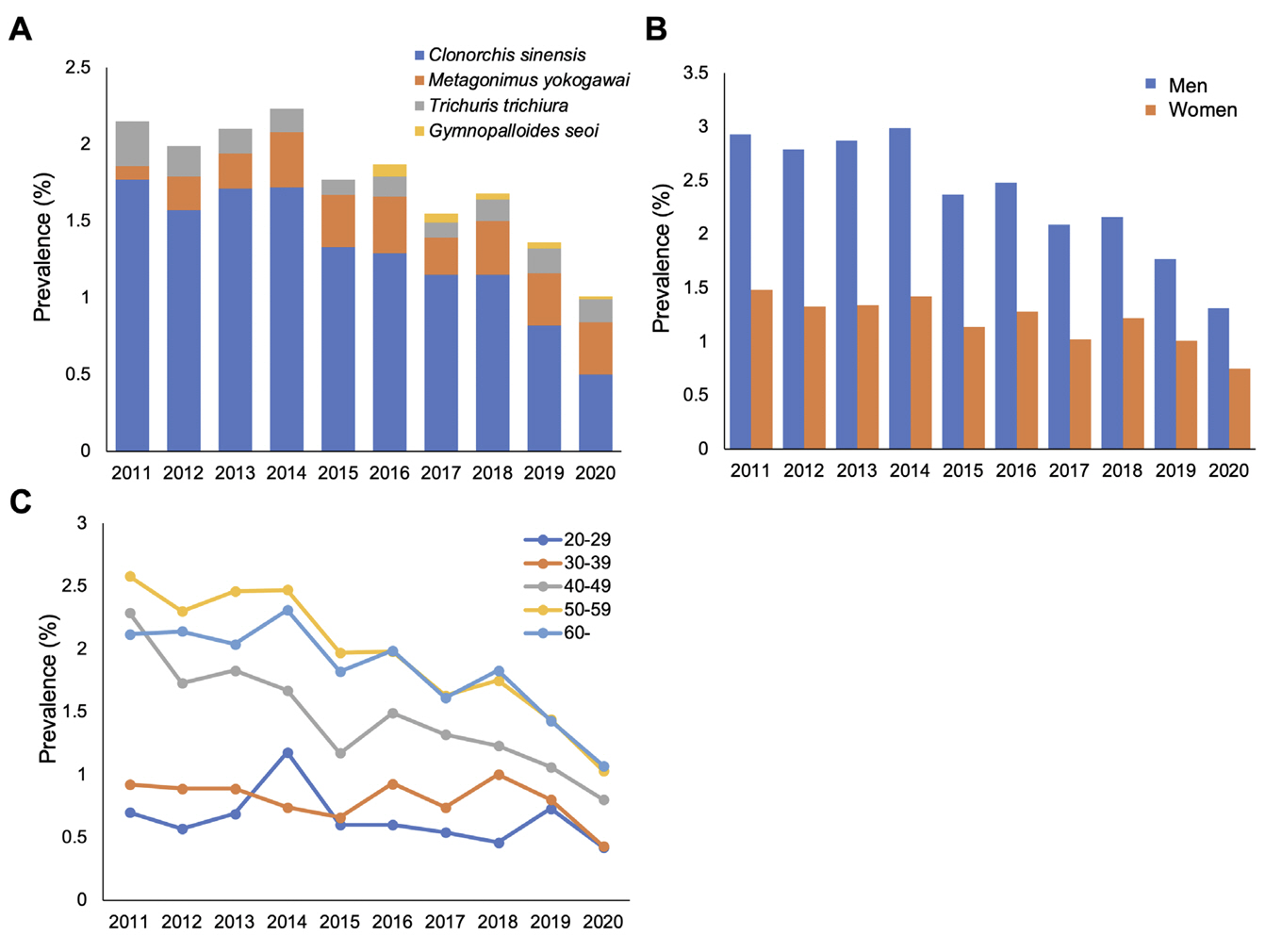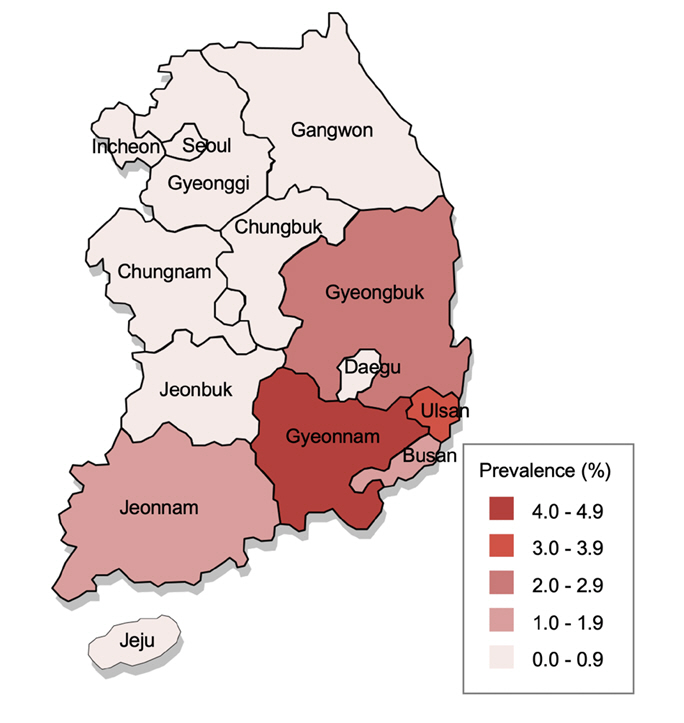Ann Clin Microbiol.
2024 Jun;27(2):41-48. 10.5145/ACM.2024.27.2.2.
Intestinal helminth infections among health examinees: 10-year (2011–2020) nationwide observations in Korea
- Affiliations
-
- 1MediCheck Research Institute, Korea Association of Health Promotion, Seoul, Korea
- 2Korea Association of Health Promotion, Seoul, Korea
- 3Department of Tropical Medicine and Parasitology, Seoul National University College of Medicine, Seoul, Korea
- KMID: 2557877
- DOI: http://doi.org/10.5145/ACM.2024.27.2.2
Abstract
- Background
A nationwide anti-parasite control program (1969–1995) successfully reduced soil-transmitted helminth infections; however, fish-borne trematode infections persisted in some areas. Since the 2012 National Parasite Infection Survey, information on the current status of intestinal helminth infections has not been updated. Analysis of the current trends in intestinal helminth infections is necessary to prevent and manage parasitic diseases in Korea.
Methods
This retrospective study analyzed the prevalence of intestinal parasites in 1,211,799 individuals who visited 16 regional branches of the Korea Association of Health Promotion between 2011 and 2020. Examinations were performed using microscopy and Kato's method. The results were analyzed according to parasite species, year, sex, age, and region of origin.
Results
Intestinal helminth infections remained above 2.0% from 2011 to 2014 but decreased to 1.0% by 2020. Clonorchis sinensis had the highest infection rate (1.3%), followed by Metagonimus yokogawai (0.3%) and Trichuris trichiura (0.2%). Men had a higher infection rate (2.4%) than that of women (1.2%). The infection rate was higher among those in their 50s (2.0%), 60s, and older (1.8%). The highest regional infection rates were observed in Gyeongnam (4.8%), Ulsan (3.1%), Gyeongbuk (2.5%), Busan (1.8%), and Jeonnam (1.6%).
Conclusion
These results provide valuable insights into the decreasing prevalence and epidemiological characteristics of intestinal helminth infections in the Korean population. Therefore, various control measures are needed to prevent intestinal helminth infections, and continuous monitoring is essential until they are eradicated.
Keyword
Figure
Reference
-
1. Jing YF, Young DJ, Huang Q, Mi Y, Zhang SC, Hu FL. Amino group decorated coordination polymers for enhanced detection of folic acid. Spectrochim Acta A Mol Biomol Spectrosc 2020;238:118443 .2. Hong ST and Yong TS. Review of successful control of parasitic infections in Korea. Infect Chemother 2020;52:427-40. .3. Kim TS, Cho SH, Huh S, Kong Y, Sohn WM, Hwang SS, et al.; Working Groups in National Institute of Health; Korea Association of Health Promotion. A nationwide survey on the prevalence of intestinal parasitic infections in the Republic of Korea, 2004. Korean J Parasitol 2009;47:37-47. .4. Jeong YI, Shin HE, Lee SE, Cheun HI, Ju JW, Kim JY, et al. Prevalence of Clonorchis sinensis infection among residents along 5 major rivers in the Republic of Korea. Korean J Parasitol 2016;54:215-9. .5. Lee MR, Ju JW, Baek SO, Lee YJ, Lee HI. Infection status of intestinal helminths in 2022. Public Health Week Rep 2022;15:1780-3. .6. Korea Centers for Disease Control and Prevention, Korea Nation Institute of Health. National survey of the prevalence of intestinal parasitic infections in Korea, 2012. The 8th Report. Osong: Korea Centers for Disease Control and Prevention; 2013. .7. Speich B, Utzinger J, Marti H, Ame SM, Ali SM, Albonico M, et al. Comparison of the KatoKatz method and ether-concentration technique for the diagnosis of soil-transmitted helminth infections in the framework of a randomised controlled trial. Eur J Clin Microbiol Infect Dis 2014;33:815-22. .8. Kato K and Miura M. Comparative examinations. Jpn J Parasitol 1954;3:35. .9. Katz N, Chaves A, Pellegrino J. A simple device for quantitative stool thick-smear technique in schistosomiasis mansoni. Rev Inst Med Trop Sao Paulo 1972;14:397-400. .10. Santos FL, Cerqueira EJ, Soares NM. Comparison of the thick smear and Kato-Katz techniques for diagnosis of intestinal helminth infections. Rev Soc Bras Med Trop 2005;38:196-8. .11. Garcia JA, Martin AM, Perez MJ. Valoración de los métodos utilizados en el diagnóstico de parasitosis intestinales. Laboratório 1985;79:473. .12. Martin LK and Beaver PC. Evaluation of Kato thick-smear technique for quantitative diagnosis of helminth infections. Am J Trop Med Hyg 1968;17:382–91. .
- Full Text Links
- Actions
-
Cited
- CITED
-
- Close
- Share
- Similar articles
-
- Status of Helminthic Infections in Residents around River Basins in the Republic of Korea for 10 Years (2011-2020)
- Recent patterns of intestinal helminth infections among the residents in Taegu City, Korea
- A study on Perception and attitudes of Examinees of Health Screening Center towards health Examination
- Review of Successful Control of Parasitic Infections in Korea
- Exploration of examinees' traits that affect the score of Korean Medical Licensing Examination



